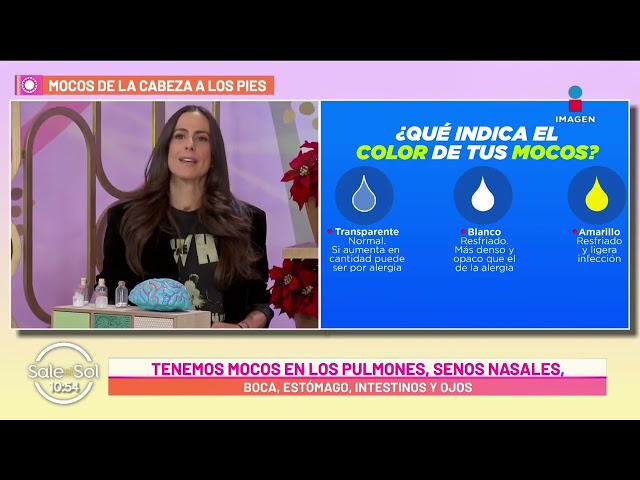



The nasal congestion It is a common problem that affects millions of people around the world. This discomfort presents itself as an obstruction in the upper airwaysmainly in the nose, which can make breathing difficult and cause discomfort. The causes of nasal congestion can vary from viral diseases to environmental factors.
Dr. Carlos León, allergist and Director of the Asthma and Allergy Center of Mexico, points out that the two main causes They are viral rhinitis and allergic rhinitis.
You might be interested in reading: What is B complex, what is it for and when should you take it?
“The most common I would say are two. One is acute viral rhinitis, which is known as the common cold. And the second is allergic rhinitis, which is not infectious, but causes both acute and chronic nasal obstruction.”
Main causes of nasal congestion
viral rhinitis
Viral rhinitis, commonly known as coldis an acute infection that affects the upper respiratory tract. According to Dr. León, this is one of the most common causes of nasal congestion temporary:
“It’s what most people call ‘the flu,’ although the more correct term is the common cold.”
Symptoms of viral rhinitis include nasal obstruction, sore throat, and general malaise, but they usually resolve within a week. However, when congestion persists for more than 10 days, Dr. León recommends go to a doctor to rule out complications: “If this lasts more than 10 days, it is not normal and you should ask for help.”
Allergic rhinitis
Allergic rhinitis is triggered by a reaction of the body to allergens such as dust, mites, or pollen. Dr. León explains that people with allergic rhinitis have symptoms such as clear mucusnasal itching, and sneezing.
“In the case of allergies, there will be no fever or body pain, but the patient will mostly have clear mucus, a stuffy nose, itching and sneezing,” the specialist mentions.
This condition It is usually chronic and requires ongoing treatment. Patients can identify the allergens that affect them by observing the circumstances in which their symptoms worsen, as Dr. León explains.
“If you go to a friend’s house who has cats and you get sick, you already know that you are probably allergic to cats.”
Environmental factors could cause nasal congestion
The environment can also influence the appearance of nasal congestion, and Dr. León describes it clearly.
“Any type of pungent odor, such as the use of deodorants, insecticides or environmental pollution, can cause nasal obstruction.”
This type of congestion It can be temporary or become a chronic problemdepending on the sensitivity of each person.
Some patients develop a condition called vasomotor rhinitiswhich responds more to the climate and temperature changes than to allergens. According to the doctor. León, this rhinitis is very similar to allergic rhinitis, but “it responds more to changes in temperature and pollution than to allergens.”
Recommended treatments against nasal congestion
Antihistamines and decongestants
Treatment for nasal congestion depends on its cause. In the case of allergic rhinitis, Dr. León mentions that antihistamines are very effective.
“These medications block the action of histamine, which is responsible for allergic symptoms.”
For viral rhinitis, nasal decongestants can offer temporary reliefbut they should be used with caution:
“The ideal is to use them twice a day, no more than three to five days, to avoid drug rhinitis or the rebound effect,” warns Dr. León.
Nasal washes
Nasal washes are a safe and effective option for both adults and children. Dr. León recommends the use of saline solutions or sea water to help clean the nasal passages.
“These washes help remove mucus and other irritants from the nose, but should always be recommended by a doctor, especially in young children.”
Avoid irritants
Avoid environmental factors that cause irritation It is key to controlling nasal congestion. Dr. León emphasizes the importance of identifying the elements that affect the patient.
“If you know that dust or certain cleaning products affect you, it is best to avoid them as much as possible.”
Furthermore, for people who They live in areas with high environmental pollutionthe use of face masks can be an effective measure to protect the respiratory tract.
“The mask not only protects you from viruses and bacteria, but also from pollution and allergens,” explains the specialist.
When to see a doctor for nasal congestion
Dr. León emphasizes that nasal congestion It’s not always a minor problem. and can require medical attention in certain cases.
“If nasal obstruction lasts more than a week or is accompanied by facial pain, high fever or loss of smell, it is important to consult a specialist to rule out more serious conditions such as chronic sinusitis or nasal polyps.”
Home remedies for nasal congestion
Although Dr. Carlos León emphasizes that it is important to have a medical diagnosis before treating nasal congestionalso points out that There are some home remedies which can temporarily relieve symptoms.
Among these, the most recommended are the saline nasal washes: “The most harmless thing you can use is a spray or aerosol of saline or sea water, as it helps clear the nasal passages without causing side effects.”
Other remedies such as steam inhalation with hot water They can also offer temporary relief, as the steam helps open the airways; However, Dr. León warns against the use of substances such as eucalyptus or menthol, which can give a feeling of momentary well-being but aggravate congestion.
“It has been shown that eucalyptus and menthol can aggravate nasal and bronchial obstruction.”
bgpa
bgpa


